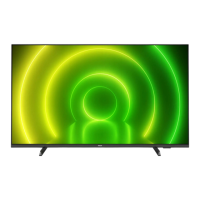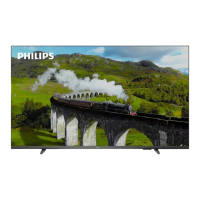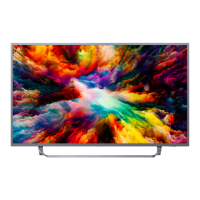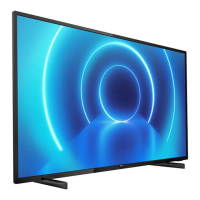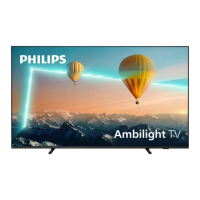Do you have a question about the Philips 43PUS7805/60 and is the answer not in the manual?
Details on finding your TV's model and serial number for registration and support.
Accessing the TV's built-in help and user manual for troubleshooting.
Information on contacting consumer care for support, repair services, and warranty.
Steps to update the TV's software via the internet or a USB drive.
Procedure to check the current software version installed on the TV.
Guide to the remote control's buttons, battery replacement, and cleaning.
Instructions for pairing the remote control with the TV, essential for voice commands.
Details on the IR sensor and using the joystick for basic TV operations.
Emphasizes reading safety instructions before using the TV.
Guidance on optimal TV placement, wall mounting, and stand installation.
Instructions for connecting power, turning the TV on, and managing standby mode.
Advice on connecting devices for the best audio and video quality.
Connecting antennas for terrestrial TV and satellite dishes.
Connecting video via HDMI and audio via optical or HDMI ARC.
Wireless connection for mobile devices via Miracast and the TV Remote App.
Connecting USB drives for media and devices like CAM modules.
Overview of connected devices and how to select them as the TV input source.
Instructions for renaming connected devices in the source list for easier identification.
How to switch, view, and manage TV channels, including icons and radio.
Installing channels via antenna, cable, or satellite, and configuring scan settings.
Searching for satellites, configuring LNB, adding/removing satellites, and managing reception.
Copying lists, managing options like subtitles, and opening the channel list.
Creating, managing favourite channels, and using Teletext features.
Understanding what's needed to use the TV Guide, including data sources.
How to use the TV Guide for program information, tuning, and setting reminders.
Step-by-step guide for scheduling program recordings using the TV Guide.
Requirements, scheduling, and manual recording of TV programs.
Viewing, managing, and renaming recorded programs.
How to pause, resume, and watch live TV broadcasts.
Connecting USB drives and general warnings.
Viewing standard and 360 photos, slideshows, and options.
Playing video files, controlling playback, and viewing file information.
Playing music files, controlling playback, and viewing file information.
Exploring the Home menu and its different sections.
How to access frequent settings and the comprehensive 'All Settings' menu.
Adjusting picture styles, contrast, sharpness, brightness, and expert settings.
Selecting preset sound styles and customizing personal sound modes.
Configuring volume control, speaker output, dialogue enhancement, and equalizer.
Configuring USB, keyboard, mouse, HDMI-CEC, and HDMI Ultra HD.
Managing energy saving modes, shop display settings, and demo content.
Configuring universal access, dialogue, and parental locks.
Changing TV menu language, and setting audio/subtitle/teletext preferences.
Configuring the TV clock, time zone, and automatic standby timer.
Connecting the TV to your home network for internet access.
Connecting wirelessly via Wi-Fi or using a wired Ethernet connection.
Viewing network status, configuring static IP, and managing Wi-Fi settings.
Initial configuration for Smart TV, including connection and terms agreement.
Accessing apps, the internet browser, and other Smart TV features.
Browsing apps, finding services like YouTube, and renting movies online.
Selecting Ambilight styles based on video, audio, colour, flag, or app.
Setting up Philips Hue bulbs with Ambilight, linking bridges, and configuring bulbs.
Adjusting wall colour influence and Ambilight behavior on TV switch off.
Using Ambilight for ambient lighting when the TV is in standby.
Instructions for accessing and using the Netflix app on the TV.
Instructions for accessing and using the Amazon Prime Video app on the TV.
Instructions for accessing and using the YouTube app on the TV.
Information about Alexa voice control, requirements, and supported languages.
Setup process for using Alexa voice control with your TV.
Information on the TV's energy efficiency class and consumption.
Detailed technical specifications including screen size and power consumption.
Guidelines for proper disposal of old products and batteries.
Power requirements, operating conditions, and tuner specifications.
Screen resolution, supported video input resolutions via HDMI.
Supported computer resolutions and detailed sound features.
Supported media formats, connections, and port overview.
Tips for finding solutions, using help resources, and contacting support.
Resolving TV startup, remote control, channel finding, and satellite problems.
Troubleshooting display, audio quality, and HDMI connection issues.
Resolving USB playback, Wi-Fi connectivity, and incorrect menu language problems.
Important safety instructions regarding electricity, heat, and physical handling.
Safety guidelines for lightning storms, temperature, humidity, and hearing protection.
Proper methods for cleaning the TV screen and frame to avoid damage.
Warranty terms, pixel characteristics, and legal disclaimers.
CE compliance, EMF standards, and TP Vision's commitment to safety.
Details on HDMI and High-Definition Multimedia Interface trademarks.
Information on Dolby Audio and DTS-HD trademarks and licensing.
Information on obtaining the source code for open source software used in the TV.
Details about open source licenses (GPL, LGPL) and warranty disclaimers.
Disclaimer about changes, suspension, or termination of third-party services/software.
Details on finding your TV's model and serial number for registration and support.
Accessing the TV's built-in help and user manual for troubleshooting.
Information on contacting consumer care for support, repair services, and warranty.
Steps to update the TV's software via the internet or a USB drive.
Procedure to check the current software version installed on the TV.
Guide to the remote control's buttons, battery replacement, and cleaning.
Instructions for pairing the remote control with the TV, essential for voice commands.
Details on the IR sensor and using the joystick for basic TV operations.
Emphasizes reading safety instructions before using the TV.
Guidance on optimal TV placement, wall mounting, and stand installation.
Instructions for connecting power, turning the TV on, and managing standby mode.
Advice on connecting devices for the best audio and video quality.
Connecting antennas for terrestrial TV and satellite dishes.
Connecting video via HDMI and audio via optical or HDMI ARC.
Wireless connection for mobile devices via Miracast and the TV Remote App.
Connecting USB drives for media and devices like CAM modules.
Overview of connected devices and how to select them as the TV input source.
Instructions for renaming connected devices in the source list for easier identification.
How to switch, view, and manage TV channels, including icons and radio.
Installing channels via antenna, cable, or satellite, and configuring scan settings.
Searching for satellites, configuring LNB, adding/removing satellites, and managing reception.
Copying lists, managing options like subtitles, and opening the channel list.
Creating, managing favourite channels, and using Teletext features.
Understanding what's needed to use the TV Guide, including data sources.
How to use the TV Guide for program information, tuning, and setting reminders.
Step-by-step guide for scheduling program recordings using the TV Guide.
Requirements, scheduling, and manual recording of TV programs.
Viewing, managing, and renaming recorded programs.
How to pause, resume, and watch live TV broadcasts.
Connecting USB drives and general warnings.
Viewing standard and 360 photos, slideshows, and options.
Playing video files, controlling playback, and viewing file information.
Playing music files, controlling playback, and viewing file information.
Exploring the Home menu and its different sections.
How to access frequent settings and the comprehensive 'All Settings' menu.
Adjusting picture styles, contrast, sharpness, brightness, and expert settings.
Selecting preset sound styles and customizing personal sound modes.
Configuring volume control, speaker output, dialogue enhancement, and equalizer.
Configuring USB, keyboard, mouse, HDMI-CEC, and HDMI Ultra HD.
Managing energy saving modes, shop display settings, and demo content.
Configuring universal access, dialogue, and parental locks.
Changing TV menu language, and setting audio/subtitle/teletext preferences.
Configuring the TV clock, time zone, and automatic standby timer.
Connecting the TV to your home network for internet access.
Connecting wirelessly via Wi-Fi or using a wired Ethernet connection.
Viewing network status, configuring static IP, and managing Wi-Fi settings.
Initial configuration for Smart TV, including connection and terms agreement.
Accessing apps, the internet browser, and other Smart TV features.
Browsing apps, finding services like YouTube, and renting movies online.
Selecting Ambilight styles based on video, audio, colour, flag, or app.
Setting up Philips Hue bulbs with Ambilight, linking bridges, and configuring bulbs.
Adjusting wall colour influence and Ambilight behavior on TV switch off.
Using Ambilight for ambient lighting when the TV is in standby.
Instructions for accessing and using the Netflix app on the TV.
Instructions for accessing and using the Amazon Prime Video app on the TV.
Instructions for accessing and using the YouTube app on the TV.
Information about Alexa voice control, requirements, and supported languages.
Setup process for using Alexa voice control with your TV.
Information on the TV's energy efficiency class and consumption.
Detailed technical specifications including screen size and power consumption.
Guidelines for proper disposal of old products and batteries.
Power requirements, operating conditions, and tuner specifications.
Screen resolution, supported video input resolutions via HDMI.
Supported computer resolutions and detailed sound features.
Supported media formats, connections, and port overview.
Tips for finding solutions, using help resources, and contacting support.
Resolving TV startup, remote control, channel finding, and satellite problems.
Troubleshooting display, audio quality, and HDMI connection issues.
Resolving USB playback, Wi-Fi connectivity, and incorrect menu language problems.
Important safety instructions regarding electricity, heat, and physical handling.
Safety guidelines for lightning storms, temperature, humidity, and hearing protection.
Proper methods for cleaning the TV screen and frame to avoid damage.
Warranty terms, pixel characteristics, and legal disclaimers.
CE compliance, EMF standards, and TP Vision's commitment to safety.
Details on HDMI and High-Definition Multimedia Interface trademarks.
Information on Dolby Audio and DTS-HD trademarks and licensing.
Information on obtaining the source code for open source software used in the TV.
Details about open source licenses (GPL, LGPL) and warranty disclaimers.
Disclaimer about changes, suspension, or termination of third-party services/software.
| Screen Size | 43 inches |
|---|---|
| Display Technology | LED |
| Smart TV | Yes |
| HDMI Ports | 3 |
| USB Ports | 2 |
| Audio Output | 20 W |
| Operating System | Android TV |
| Ambilight | Yes |
| Digital Audio Output (Optical) | Yes |
| Ethernet Port | Yes |
| Wi-Fi | Yes |
| Bluetooth | Yes |
| Refresh Rate | 60 Hz |
| Resolution | 4K UHD (3840 x 2160) |
| HDR Support | Yes |
| Weight | 8.2 kg |



